Jwst
- All
- News
- Videos
- Web Stories
-

NASA’s James Webb Space Telescope Reveals the Complex Structure of a Planetary Nebula
- Wednesday April 16, 2025
- Written by Gadgets 360 Staff
NASA's James Webb Space Telescope has unveiled the complex character of NGC 1514, a planetary nebula developing over at least 4,000 years. Only seen in infrared light, the nebula's rings now resemble "fuzzy" clusters set in twisted patterns. A network of sharper holes near the centre stars indicates where faster material punched through.
-
 www.gadgets360.com
www.gadgets360.com
-

Astronomers Detect Methane in the Atmosphere of the Nearest T Dwarf Star to Earth
- Saturday April 12, 2025
- Written by Gadgets 360 Staff
Astronomers have detected methane in the nearest known T dwarf, offering new insight into its atmospheric composition. The study further highlights that the carbon abundance in the planet is estimated to be -1.5 dex, while the effective temperature could be around 1,000 K. The author of the paper further revealed that the low metallicity of the T ...
-
 www.gadgets360.com
www.gadgets360.com
-

JWST Captures Unseen Details of Exoplanets in HR 8799 and 51 Eridani Systems
- Thursday April 3, 2025
- Written by Gadgets 360 Staff
The James Webb Space Telescope (JWST) has captured groundbreaking images of exoplanets in the HR 8799 and 51 Eridani systems. By modifying its coronagraphs, astronomers allowed more starlight to pass through, revealing clearer planetary details. The study, published in The Astrophysical Journal Letters, highlights the first successful detection of ...
-
 www.gadgets360.com
www.gadgets360.com
-

James Webb Telescope Captures Neptune’s Auroras in Stunning Detail
- Monday March 31, 2025
- Written by Gadgets 360 Staff
The James Webb Space Telescope has provided the first-ever direct images of Neptune’s auroras, revealing surprising details about the ice giant’s atmosphere. Unlike auroras on Earth, Jupiter, or Saturn, Neptune’s auroras appear across unexpected locations due to its tilted and offset magnetic field. Scientists also detected the presence of H...
-
 www.gadgets360.com
www.gadgets360.com
-

James Webb Space Telescope Captures Hourglass Nebula LBN 483 in Stunning Detail
- Tuesday March 18, 2025
- Written by Gadgets 360 Staff
The James Webb Space Telescope has captured unprecedented details of LBN 483, a nebula located 650 light-years away. The striking hourglass-shaped structure results from outflows driven by a forming binary star system. JWST’s infrared imaging and ALMA’s radio observations reveal how stellar winds, jets, and magnetic fields sculpt the nebula ove...
-
 www.gadgets360.com
www.gadgets360.com
-

James Webb Space Telescope Observes Mysterious Rogue Planet-Like Object
- Thursday March 6, 2025
- Written by Gadgets 360 Staff
The James Webb Space Telescope has captured new insights into SIMP 0136, a planetary-mass object floating freely around 20 light-years away. This celestial body, possibly a rogue planet or a brown dwarf, has puzzled astronomers for years. JWST’s infrared observations have revealed intricate cloud layers, temperature shifts, and potential chemical...
-
 www.gadgets360.com
www.gadgets360.com
-

JWST Identifies Cooling Gas in Phoenix Cluster, Unlocking Star Formation Process
- Thursday February 20, 2025
- Written by Gadgets 360 Staff
The James Webb Space Telescope has detected the missing cooling gas in the Phoenix Cluster, a galaxy cluster located 5.8 billion light-years away. Researchers used the Mid-Infrared Instrument (MIRI) to identify gas at around 540,000 degrees Fahrenheit trapped in cavities within the cluster. This discovery resolves a long-standing mystery of how sta...
-
 www.gadgets360.com
www.gadgets360.com
-

James Webb Space Telescope Captures Sagittarius A Emitting Continuous Flares in Milky Way’s Core
- Thursday February 20, 2025
- Written by Gadgets 360 Staff
The James Webb Space Telescope has captured Sagittarius A*, the Milky Way’s supermassive black hole, emitting flares continuously. These bursts, varying in intensity and duration, have been observed over multiple sessions. Scientists believe the activity may be linked to magnetic interactions within the accretion disk. The phenomenon appears rand...
-
 www.gadgets360.com
www.gadgets360.com
-

James Webb Telescope to Study Potentially Hazardous Asteroid 2024 YR4
- Thursday February 13, 2025
- Written by Gadgets 360 Staff
Asteroid 2024 YR4, identified in December 2024, has a 2.3% chance of Earth impact in December 2032. Due to uncertainties in ground-based size estimates, JWST will conduct infrared observations in March and May to determine its true dimensions. The European Space Agency estimates its width at 55 metres, but it could be as large as 90 metres. The fin...
-
 www.gadgets360.com
www.gadgets360.com
-

JWST Unveils HH 30’s Protoplanetary Disk, Showing Dust Grains and Jets
- Monday February 10, 2025
- Written by Gadgets 360 Staff
The James Webb Space Telescope has captured an extraordinary image of HH 30, a protoplanetary disk in the Taurus constellation. The dense dust disk conceals the central star, while bright jets extend outward, interacting with surrounding gas. Microscopic dust grains within the disk have been identified, playing a crucial role in planetary formation...
-
 www.gadgets360.com
www.gadgets360.com
-

High-Resolution Observations Provide New Insights into Brown Dwarf HD 206893 B
- Friday February 7, 2025
- Written by Gadgets 360 Staff
Astronomers have gained significant insights into brown dwarf HD 206893 B using high-resolution spectroscopy. The study, led by UCSD's Ben Sappey, reveals the object's mass, temperature, and formation details, contributing to brown dwarf research. Located 133 light-years away, HD 206893 B's position within a debris disk invites future investigation...
-
 www.gadgets360.com
www.gadgets360.com
-

JWST Detects Unexpectedly Massive Black Holes in the Early Universe
- Monday February 3, 2025
- Written by Gadgets 360 Staff
A new study led by Jorryt Matthee of ISTA reveals that black holes in early galaxies were significantly more massive than expected. Using JWST data, researchers found that some black holes accounted for nearly 10% of their galaxy's stellar mass—far exceeding the 0.01% ratio seen in modern galaxies. The findings challenge existing growth models, s...
-
 www.gadgets360.com
www.gadgets360.com
-

Astronomers Discover New "Super-Venus" Exoplanet, Challenging Previous Assumptions
- Friday January 24, 2025
- Science | Edited by Nikhil Pandey
The exoplanet Enaiposha (GJ 1214 b), previously thought to be a mini-Neptune, has been reclassified as a "Super-Venus" following new data from the James Webb Space Telescope (JWST).
-
 www.ndtv.com
www.ndtv.com
-

James Webb Space Telescope Unveils Hidden Interstellar Wonders of Supernova Cassiopeia A
- Friday January 17, 2025
- Written by Gadgets 360 Staff
The James Webb Space Telescope has provided a rare glimpse into the remnants of a centuries-old supernova in Cassiopeia A. Using infrared technology, the telescope captured a light echo caused by a massive star’s explosion, unveiling new insights into the interstellar medium and its magnetic structures. This breakthrough discovery offers valuable...
-
 www.gadgets360.com
www.gadgets360.com
-

James Webb Space Telescope Detects Supernova From 11.4 Billion Years Ago
- Friday January 17, 2025
- Written by Gadgets 360 Staff
Astronomers using the James Webb Space Telescope (JWST) have identified AT 2023adsv, a supernova that occurred 11.4 billion years ago. This stellar explosion, from a star 20 times the size of the Sun, offers a glimpse into the early universe's unique stellar evolution. Part of the JWST Advanced Deep Extragalactic Survey, the event highlights how th...
-
 www.gadgets360.com
www.gadgets360.com
-

NASA’s James Webb Space Telescope Reveals the Complex Structure of a Planetary Nebula
- Wednesday April 16, 2025
- Written by Gadgets 360 Staff
NASA's James Webb Space Telescope has unveiled the complex character of NGC 1514, a planetary nebula developing over at least 4,000 years. Only seen in infrared light, the nebula's rings now resemble "fuzzy" clusters set in twisted patterns. A network of sharper holes near the centre stars indicates where faster material punched through.
-
 www.gadgets360.com
www.gadgets360.com
-

Astronomers Detect Methane in the Atmosphere of the Nearest T Dwarf Star to Earth
- Saturday April 12, 2025
- Written by Gadgets 360 Staff
Astronomers have detected methane in the nearest known T dwarf, offering new insight into its atmospheric composition. The study further highlights that the carbon abundance in the planet is estimated to be -1.5 dex, while the effective temperature could be around 1,000 K. The author of the paper further revealed that the low metallicity of the T ...
-
 www.gadgets360.com
www.gadgets360.com
-

JWST Captures Unseen Details of Exoplanets in HR 8799 and 51 Eridani Systems
- Thursday April 3, 2025
- Written by Gadgets 360 Staff
The James Webb Space Telescope (JWST) has captured groundbreaking images of exoplanets in the HR 8799 and 51 Eridani systems. By modifying its coronagraphs, astronomers allowed more starlight to pass through, revealing clearer planetary details. The study, published in The Astrophysical Journal Letters, highlights the first successful detection of ...
-
 www.gadgets360.com
www.gadgets360.com
-

James Webb Telescope Captures Neptune’s Auroras in Stunning Detail
- Monday March 31, 2025
- Written by Gadgets 360 Staff
The James Webb Space Telescope has provided the first-ever direct images of Neptune’s auroras, revealing surprising details about the ice giant’s atmosphere. Unlike auroras on Earth, Jupiter, or Saturn, Neptune’s auroras appear across unexpected locations due to its tilted and offset magnetic field. Scientists also detected the presence of H...
-
 www.gadgets360.com
www.gadgets360.com
-

James Webb Space Telescope Captures Hourglass Nebula LBN 483 in Stunning Detail
- Tuesday March 18, 2025
- Written by Gadgets 360 Staff
The James Webb Space Telescope has captured unprecedented details of LBN 483, a nebula located 650 light-years away. The striking hourglass-shaped structure results from outflows driven by a forming binary star system. JWST’s infrared imaging and ALMA’s radio observations reveal how stellar winds, jets, and magnetic fields sculpt the nebula ove...
-
 www.gadgets360.com
www.gadgets360.com
-

James Webb Space Telescope Observes Mysterious Rogue Planet-Like Object
- Thursday March 6, 2025
- Written by Gadgets 360 Staff
The James Webb Space Telescope has captured new insights into SIMP 0136, a planetary-mass object floating freely around 20 light-years away. This celestial body, possibly a rogue planet or a brown dwarf, has puzzled astronomers for years. JWST’s infrared observations have revealed intricate cloud layers, temperature shifts, and potential chemical...
-
 www.gadgets360.com
www.gadgets360.com
-

JWST Identifies Cooling Gas in Phoenix Cluster, Unlocking Star Formation Process
- Thursday February 20, 2025
- Written by Gadgets 360 Staff
The James Webb Space Telescope has detected the missing cooling gas in the Phoenix Cluster, a galaxy cluster located 5.8 billion light-years away. Researchers used the Mid-Infrared Instrument (MIRI) to identify gas at around 540,000 degrees Fahrenheit trapped in cavities within the cluster. This discovery resolves a long-standing mystery of how sta...
-
 www.gadgets360.com
www.gadgets360.com
-

James Webb Space Telescope Captures Sagittarius A Emitting Continuous Flares in Milky Way’s Core
- Thursday February 20, 2025
- Written by Gadgets 360 Staff
The James Webb Space Telescope has captured Sagittarius A*, the Milky Way’s supermassive black hole, emitting flares continuously. These bursts, varying in intensity and duration, have been observed over multiple sessions. Scientists believe the activity may be linked to magnetic interactions within the accretion disk. The phenomenon appears rand...
-
 www.gadgets360.com
www.gadgets360.com
-

James Webb Telescope to Study Potentially Hazardous Asteroid 2024 YR4
- Thursday February 13, 2025
- Written by Gadgets 360 Staff
Asteroid 2024 YR4, identified in December 2024, has a 2.3% chance of Earth impact in December 2032. Due to uncertainties in ground-based size estimates, JWST will conduct infrared observations in March and May to determine its true dimensions. The European Space Agency estimates its width at 55 metres, but it could be as large as 90 metres. The fin...
-
 www.gadgets360.com
www.gadgets360.com
-

JWST Unveils HH 30’s Protoplanetary Disk, Showing Dust Grains and Jets
- Monday February 10, 2025
- Written by Gadgets 360 Staff
The James Webb Space Telescope has captured an extraordinary image of HH 30, a protoplanetary disk in the Taurus constellation. The dense dust disk conceals the central star, while bright jets extend outward, interacting with surrounding gas. Microscopic dust grains within the disk have been identified, playing a crucial role in planetary formation...
-
 www.gadgets360.com
www.gadgets360.com
-

High-Resolution Observations Provide New Insights into Brown Dwarf HD 206893 B
- Friday February 7, 2025
- Written by Gadgets 360 Staff
Astronomers have gained significant insights into brown dwarf HD 206893 B using high-resolution spectroscopy. The study, led by UCSD's Ben Sappey, reveals the object's mass, temperature, and formation details, contributing to brown dwarf research. Located 133 light-years away, HD 206893 B's position within a debris disk invites future investigation...
-
 www.gadgets360.com
www.gadgets360.com
-

JWST Detects Unexpectedly Massive Black Holes in the Early Universe
- Monday February 3, 2025
- Written by Gadgets 360 Staff
A new study led by Jorryt Matthee of ISTA reveals that black holes in early galaxies were significantly more massive than expected. Using JWST data, researchers found that some black holes accounted for nearly 10% of their galaxy's stellar mass—far exceeding the 0.01% ratio seen in modern galaxies. The findings challenge existing growth models, s...
-
 www.gadgets360.com
www.gadgets360.com
-

Astronomers Discover New "Super-Venus" Exoplanet, Challenging Previous Assumptions
- Friday January 24, 2025
- Science | Edited by Nikhil Pandey
The exoplanet Enaiposha (GJ 1214 b), previously thought to be a mini-Neptune, has been reclassified as a "Super-Venus" following new data from the James Webb Space Telescope (JWST).
-
 www.ndtv.com
www.ndtv.com
-

James Webb Space Telescope Unveils Hidden Interstellar Wonders of Supernova Cassiopeia A
- Friday January 17, 2025
- Written by Gadgets 360 Staff
The James Webb Space Telescope has provided a rare glimpse into the remnants of a centuries-old supernova in Cassiopeia A. Using infrared technology, the telescope captured a light echo caused by a massive star’s explosion, unveiling new insights into the interstellar medium and its magnetic structures. This breakthrough discovery offers valuable...
-
 www.gadgets360.com
www.gadgets360.com
-

James Webb Space Telescope Detects Supernova From 11.4 Billion Years Ago
- Friday January 17, 2025
- Written by Gadgets 360 Staff
Astronomers using the James Webb Space Telescope (JWST) have identified AT 2023adsv, a supernova that occurred 11.4 billion years ago. This stellar explosion, from a star 20 times the size of the Sun, offers a glimpse into the early universe's unique stellar evolution. Part of the JWST Advanced Deep Extragalactic Survey, the event highlights how th...
-
 www.gadgets360.com
www.gadgets360.com

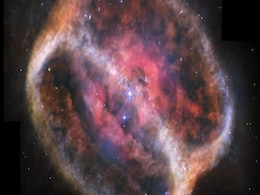





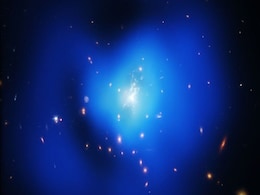
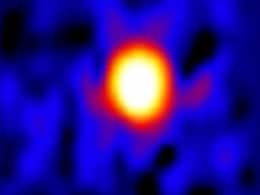
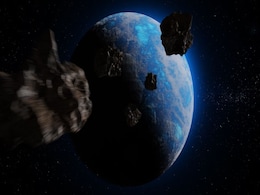




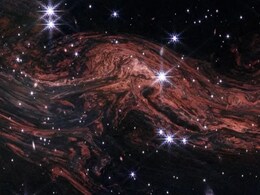

![Gadgets 360 With Technical Guruji: Did You Know? [April 6, 2024] Gadgets 360 With Technical Guruji: Did You Know? [April 6, 2024]](https://c.ndtvimg.com/2024-02/mpconh58_did-you-know_640x480_10_February_24.jpg?downsize=245:163)



